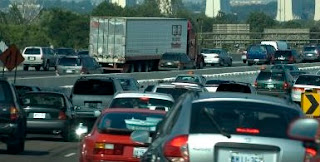Atlanta gets it rank on an Urban Mobility Scorecard - it's not so great
There’s been some brouhaha over how Atlanta ranks in the latest Texas A&M Transportation Institute findings. We’re number 12! Believe it or not, it’s far worse in 11 other metropolises in the United States.
Certainly the number 12 Atlanta traffic ranking is far from
being a cause for celebration. The study’s conclusion states that Atlanta area
commuters spend 52 hours a year in traffic. While there are some who don’t mind
puttering around listening to their favorite music, talk radio program or Lord
forbid – texting or watching videos, the fact is that we’re stuck behind the
wheel.
I’m not sure about most folks, but commuting is a major
time-waster, pollution-contributor and tough on our autos – especially those
brakes! I’m as kind as can be to my brakes, but I’m sure my brakes would like
me to give them a break.
The point here is that losing 52 hours to traffic is
unacceptable, but what should the ATL metro do about this dilemma? Indeed
communities try to tackle the issue. In Gwinnett County there was an initiative
held inviting discussion on the issue with The Gr8 Exchange on Transportation.
It’s a fresh, exciting idea which I’m sure me and thousands of others hope to
see exponentially expand leading to action being taken. In other areas like
Clayton County, there is great hope that MARTA will expand its presence in the community
making it far easier for citizens to get to work, school and stores. Cobb
County will definitely need to hold transportation discussions as they will
attract thousands to future Atlanta Braves baseball games in their new stadium
near the exchange of I-75/I-285 also known as the “Cobb Cloverleaf.”
There’s a lot of work to do in the ATL to improve traffic
flow and air quality. In addition to strengthening existing infrastructure, the
entire metro area ought to find an “All of the Above” plan. What is an “All of
the Above” approach? The “All of the Above” approach includes developing a mix
of improving existing roads, bridges, ramps, sidewalks and paths while
developing alternative transportation services including more bus routes,
light/heavy rail and bike lanes.
Speaking of bike lanes, there’s a major brouhaha over a bike
lane plan on Peachtree Road in Atlanta’s Buckhead community. In recent times,
there’s been intense interest to install bikes lanes on each side of the
already-narrow Peachtree Road. Obviously Buckhead’s auto enthusiasts are
disenchanted with the bike lane proposal while cyclists are delighted. Nevertheless,
folks on each side of the issue will be upset to a degree. Drivers will lose
some road while cyclists will see a modified version of the lanes which will
not go as far as they would like. I suppose at some point, the lanes will end
thus leaving cyclists to join the congested road again at some point or get on
the sidewalk which is illegal according to state law.
If the Buckhead community’s Peachtree Road bike lane project
will happen, it sounds like it will be a compromise. While a compromise is
better than no deal, it’s a sad state of affairs that Peachtree Road became
such a traffic-plagued corridor to get to the point in the first place. This is
the result if poor planning or basically no planning, but there’s little we can
do about that at the present. I suppose
we’ll see more scenarios like this take place throughout the metro area should
communities wish to install bike lanes or any other alternative transportation
project.
Compromise is what it will take to make a cohesive
transportation plan to take place. Not only should communities work out
compromises within their borders to make bike lanes, light/heavy rail, bus
routes and improve roads happen, but the entire metro area needs to work
together. Communities ought to take the courage to avoid “Balkanization” and
look to work with one another. Compromise is easier said than done, but taking
on a cohesive compromise is what leaders need to take to make the Atlanta metro
area successful. That success will lead to attracting jobs and improving the
area’s quality of life.

Comments